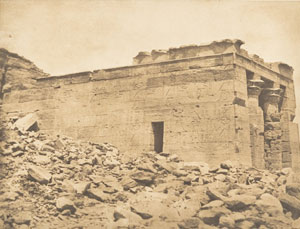The Ancients and the New
John Haberin New York City
Africa and Byzantium and Maxime Du Camp
Late in the tenth century, a Nubian wall painting shows an imposing figure in priestly robes backed by a still taller one. It is Bishop Petros protected by Saint Peter, his namesake. No surprises there, but for one thing: the bishop is black, for Nubia spanned today's southern Egypt and the Sudan. Peter, in turn, is white, for the Christianity of the Roman Empire had extended its reach to Africa, even as Rome had fallen long ago.
With "Africa and Byzantium," the Met takes a fresh look at the Byzantine empire that emerged from the division of Rome's in 395, but with the cracks showing at least two hundred years earlier. Here it no longer centers on Constantinople, or Byzantium (today's Istanbul) on the Bosporus Strait connecting Europe and Asia. It looks south, to Syria, and then west across North Africa from Egypt to Algeria— and further south to present-day Sudan and Ethiopia. Nor is it the place where painting has gone to die, in the "dark ages" between classical art and the Renaissance. It is open-minded and eclectic, a model for diversity in art now. It is where at least four major religions met, fought, and reached an ever-changing agreement.
and further south to present-day Sudan and Ethiopia. Nor is it the place where painting has gone to die, in the "dark ages" between classical art and the Renaissance. It is open-minded and eclectic, a model for diversity in art now. It is where at least four major religions met, fought, and reached an ever-changing agreement.
In October 1849, a smart young Parisian set out to see the world, and he, too, sought a bridge between Europe and Africa, the ancients and the new. Then twenty-seven, Maxime Du Camp got himself a camera and learned to use it from the best of the best, Gustave Le Gray. Then he grabbed a close friend, Gustave Flaubert, and headed for Egypt and the Middle East. He returned after a year and a half with two hundred negatives of pyramids, ancient temples, mosques, and now and then signs of life. The oldest of the old and the newest of the new, in technology and in art—what could better suit a man confident in his talents and eager for attention. He might not mind one bit to see it all again as "Proof: Eastern Mediterranean and North Africa."
Sailing to Byzantium
William Butler Yeats in "Sailing to Byzantium" had it wrong. This is a country for old men (and women), with a respect for authority and antiquity. More than a hundred years after Saint Peter, Jesus looks after a Nubian dignitary. The two wall paintings are so alike in style and dimensions that they could have been painted together. These really are "monuments of unaging intellect," but an intellect that accommodates Christianity, Roman gods, the Coptic culture of Egypt, and Jewish scholars in Alexandria and Tunis. Nubian armies repelled Islamic invaders, but by all means throw the Koran into the mix.
To ask the Met, histories of Western art have had it wrong, too. Byzantine art may have you thinking of Madonnas, where the child gestures regally but stiffly and well-articulated folds in her black robe only bring out their flatness. Gilding makes them look that much more inert, and the harsh outlines of their features make them look as if they were squinting. And sure, many such icons appear here, but in an open, fluid history. Rather than a sudden turn from classicism to darkness and back, it presents a continuing narrative connecting and explaining them all. It has room for blackness, too, although the ultimate authorities are white.
The show opens with mosaics, in a firmly classical world. Their pale colors have all the brightness of ancient Rome, with well-articulated figures in wide-open spaces, stretching their limbs as they prepare for a feast. Then come small jugs in African red clay, in the shape of heads with whimsical faces, and bowls, a lion, and a dolphin in clear rock crystal. The sheer variety of media stands out, as does the debt at once to Rome and Africa. Jewelry, textiles, and carved boxes for precious possessions confirm the picture. The bronze bust of a crying child picks up where the red clay left off, but with the poignancy of being young, helpless, and black.
A textile shows Greek or Roman gods, but also black. Do not be surprised either if similar figures appear to either side of a Madonna and Child. What religion is this, and which myth is which? Here Christianity claims everything and anything for its own. The flattening comes soon enough, but its disrespect for naturalism allows other liberties. Why stop with an icon when you can throw in as many Biblical or folk anecdotes as you like? The heads of apostles as oil lamps run to further whimsy, even as the icons deny it.
How good is this history? I am well outside my expertise. As with shows of early Buddhism and women of Mesopotamia, I may not contribute something beyond a recommendation the way, I have argued, a critic should. I can only share my personal encounter, from the perspective of European and contemporary American art—including art that itself journeys to Africa. Bear in mind, too, the Met's nasty habit of presenting a curator's minority interpretation as law. In shifting the focus to North Africa, has it left both Byzantium and African art behind?
It is fascinating all the same, and the many languages on display make a strong case as well. The curators, led by Andrea Achi, get to ask if you knew that Sudan has more pyramids than ancient Egypt. The last room throw in a few living artists who respond to tradition with pattern and decoration. Given museum trends toward making everything about contemporary art, I can only be grateful that there are not more of them. Think of the exhibition as not history alone, but an ideal. I can live with that, a white lie, and a black Artemis.
The oldest and the new
So what was Maxime Du Camp after, civilizations or something larger than life? What, for that matter, was a camera to him, the latest art form or a tool of scientific clarity? He had no shortage of support for them all. He had the encouragement of France's Minister of Public Instruction, who urged him to remember photography's "uncontestable exactitude." Once back home, he got to work with Blanquart-Evrard, France's first commercial photographic press. Its crisp, cool shades of black and white echoed both that exactitude and a popular art form, lithography.
But then why choose? Just a generation after Napoleon's aspirations to empire and so soon after the invention of photography, the pyramids and the camera alike still felt novel and still inspired awe. Critics dismissed the prints as "vaporous" or derivative of contemporary prints, but the public disagreed. A publisher selected more than half the images for a book, Egypte, Nubie, Palestine, et Syrie—the first in France with photographs as illustrations. Du Camp's career as a writer and journalist was off to a good start, and he never looked back. He traded the camera for a decent sofa.
 Not that everything went smoothly. Chemical salts on paper negatives could not stand up to a long journey and desert heat. Fortunately, the same wet treatment that produced those cool tones also revived the negatives. Fortunately, too, they did not stop Du Camp from making his own "proof prints," possibly in conjunction with Le Gray. They have entered the Met's collection, which naturally prefers them. It relishes the greater warmth of their pale yellow-gray.
Not that everything went smoothly. Chemical salts on paper negatives could not stand up to a long journey and desert heat. Fortunately, the same wet treatment that produced those cool tones also revived the negatives. Fortunately, too, they did not stop Du Camp from making his own "proof prints," possibly in conjunction with Le Gray. They have entered the Met's collection, which naturally prefers them. It relishes the greater warmth of their pale yellow-gray.
You can decide for yourself, for the museum displays both versions of quite a few. I like both the sharpness of black and white and texture in yellow-gray skies—even while knowing that they may have come about in the darkroom by smearing more chemicals over the skies to remove signs of contemporary life. The exotic for its own sake was just too appealing for Du Camp to pass up. People appear only as props to set off the amazing scale of temples, pillars, statues, and windswept sands. Flaubert himself shows up just once, and he seems to have slouched onto the scene rather than posed for the camera. The novelist had his own uncontestable exactitude in prose, but Du Camp never so much as mentions him in an account of their journey.
Not that the Met withholds criticism. It sees the photos as condescending to a foreign culture, but I am not so sure. If anything, Du Camp seems largely indifferent to culture, whether ancient or Islamic. The show has just a few prints by others, and he just cannot match them. They bring their structures closer to the viewer, for a sense of art and life. He has something else in mind—density, detail, and mass.
He likes a residential neighborhood in Cairo for its balconies and box-like gardens, not its inhabitants at work, at prayer, or at play. He likes scenes divided between bulky structures and utter ruins, but without a moral. He likes to center a panorama on an ancient dome or minaret, but they pop out of nowhere, more as landmarks than signs of foolishness or faith. One might never know that anyone saw the Middle East as a holy land. As he travels down the Nile to what was then the Nubia, in present-day Egypt and Sudan, he finally gets fully into ancient ambitions, but he wants them all for himself. He alone holds the proof.

"Africa and Byzantium" ran at The Metropolitan Museum of Art through March 3, 2024, Maxime Du Camp through January 21.




